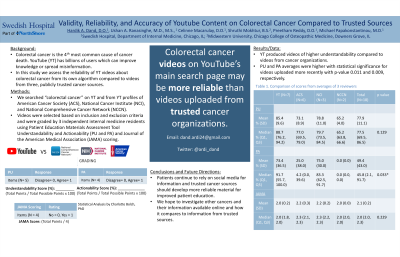Sunday Poster Session
Category: Colorectal Cancer Prevention
P0368 - Validity, Reliability, and Accuracy of Youtube Content on Colorectal Cancer Compared to Trusted Sources
Sunday, October 22, 2023
3:30 PM - 7:00 PM PT
Location: Exhibit Hall

Has Audio

Hardik A. Dand, DO
Swedish Hospital
Chicago, IL
Presenting Author(s)
Hardik A. Dand, DO1, Ushan A. Ranasinghe, MD, MS2, Celinne Macarulay, DO1, Shruthi Mokhtur, BS3, Michael Papakonstantinou, MD1, Preetham Reddy, DO, BS4
1Swedish Hospital, Chicago, IL; 2Swedish Hospital, part of Northshore University Health System, Chicago, IL; 3Midwestern University Chicago College of Osteopathic Medicine, Lake Zurich, IL; 4Swedish Hospital, Chicago, FL
Introduction: In the US, colorectal cancer is the fourth most common type of cancer and cause of cancer death in both men and women. YouTube (YT), a global social media platform that could be utilized to improve public understanding and awareness of diseases. It can also be used to disseminate misleading and harmful information. YT has a key role in public health. This study assesses the reliability of YT videos about colorectal cancer using its own algorithm compared to videos from three cancer organizations.
Methods: On 12/2022, we searched “colorectal cancer” on YT and selected videos from the top 10 with the most views. Then, “colorectal” was searched from YT profiles of American Cancer Society (ACS), National Cancer Institute (NCI), and National Comprehensive Cancer Network (NCCN). Criteria required videos to be less than 10 minutes and have “colon, rectal, or colorectal” in the description. Videos that were non-English language, uploaded more than 15 years ago, patient stories, drug advertisements, and pharmaceutical company sponsored were excluded. The videos were graded by 3 independent internal medicine residents using the validated methods of Patient Education Materials Assessment Tool Understandability and Actionability (PU and PA) and Journal of the American Medical Association (JAMA) scoring. Higher percentages of PU and PA depicted more understandable and actionable material. Higher JAMA score (up to 4) indicated better quality of information. Descriptive statistics and non-parametric Kruskal-Wallis tests were done.
Results: A total of 18 videos were identified. PU mean was 85.4% (SD 9.6) in YT compared to 73.1% (SD 8.9), 78.8% (SD 11), and 65.2% (SD 4) for ACS, NCI, and NCCN respectively. PA mean was 73.4% (SD 36.4) for YT compared to 25% (SD 38) and 75% (SD 30), for ACS and NCI respectively. The JAMA average was 2.0 (SD 0.2) for YT compared to 2.2 (SD 0.3), 2.2 (SD 0.2), and 2.0 (SD 0) for ACS, NCI, and NCCN respectively. PU and PA averages were higher with statistical significance for videos uploaded more recently with p-value 0.009 for both metrics.
Discussion: YouTube produced videos of higher understandability compared to videos from cancer organizations. As patients continue to rely on social media for information, trusted cancer sources should develop higher quality videos that are more reliable and comprehensive to avoid increasing spread of misinformation.
Disclosures:
Hardik A. Dand, DO1, Ushan A. Ranasinghe, MD, MS2, Celinne Macarulay, DO1, Shruthi Mokhtur, BS3, Michael Papakonstantinou, MD1, Preetham Reddy, DO, BS4. P0368 - Validity, Reliability, and Accuracy of Youtube Content on Colorectal Cancer Compared to Trusted Sources, ACG 2023 Annual Scientific Meeting Abstracts. Vancouver, BC, Canada: American College of Gastroenterology.
1Swedish Hospital, Chicago, IL; 2Swedish Hospital, part of Northshore University Health System, Chicago, IL; 3Midwestern University Chicago College of Osteopathic Medicine, Lake Zurich, IL; 4Swedish Hospital, Chicago, FL
Introduction: In the US, colorectal cancer is the fourth most common type of cancer and cause of cancer death in both men and women. YouTube (YT), a global social media platform that could be utilized to improve public understanding and awareness of diseases. It can also be used to disseminate misleading and harmful information. YT has a key role in public health. This study assesses the reliability of YT videos about colorectal cancer using its own algorithm compared to videos from three cancer organizations.
Methods: On 12/2022, we searched “colorectal cancer” on YT and selected videos from the top 10 with the most views. Then, “colorectal” was searched from YT profiles of American Cancer Society (ACS), National Cancer Institute (NCI), and National Comprehensive Cancer Network (NCCN). Criteria required videos to be less than 10 minutes and have “colon, rectal, or colorectal” in the description. Videos that were non-English language, uploaded more than 15 years ago, patient stories, drug advertisements, and pharmaceutical company sponsored were excluded. The videos were graded by 3 independent internal medicine residents using the validated methods of Patient Education Materials Assessment Tool Understandability and Actionability (PU and PA) and Journal of the American Medical Association (JAMA) scoring. Higher percentages of PU and PA depicted more understandable and actionable material. Higher JAMA score (up to 4) indicated better quality of information. Descriptive statistics and non-parametric Kruskal-Wallis tests were done.
Results: A total of 18 videos were identified. PU mean was 85.4% (SD 9.6) in YT compared to 73.1% (SD 8.9), 78.8% (SD 11), and 65.2% (SD 4) for ACS, NCI, and NCCN respectively. PA mean was 73.4% (SD 36.4) for YT compared to 25% (SD 38) and 75% (SD 30), for ACS and NCI respectively. The JAMA average was 2.0 (SD 0.2) for YT compared to 2.2 (SD 0.3), 2.2 (SD 0.2), and 2.0 (SD 0) for ACS, NCI, and NCCN respectively. PU and PA averages were higher with statistical significance for videos uploaded more recently with p-value 0.009 for both metrics.
Discussion: YouTube produced videos of higher understandability compared to videos from cancer organizations. As patients continue to rely on social media for information, trusted cancer sources should develop higher quality videos that are more reliable and comprehensive to avoid increasing spread of misinformation.
Disclosures:
Hardik Dand indicated no relevant financial relationships.
Ushan Ranasinghe indicated no relevant financial relationships.
Celinne Macarulay indicated no relevant financial relationships.
Shruthi Mokhtur indicated no relevant financial relationships.
Michael Papakonstantinou indicated no relevant financial relationships.
Preetham Reddy indicated no relevant financial relationships.
Hardik A. Dand, DO1, Ushan A. Ranasinghe, MD, MS2, Celinne Macarulay, DO1, Shruthi Mokhtur, BS3, Michael Papakonstantinou, MD1, Preetham Reddy, DO, BS4. P0368 - Validity, Reliability, and Accuracy of Youtube Content on Colorectal Cancer Compared to Trusted Sources, ACG 2023 Annual Scientific Meeting Abstracts. Vancouver, BC, Canada: American College of Gastroenterology.
